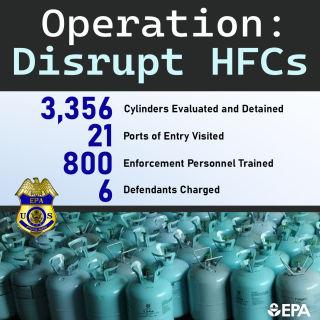Operation: Disrupt HFCs
What are HFCs?

Hydrofluorocarbons (HFCs) are potent greenhouse gases with high global warming potential. HFCs are used as refrigerants, aerosol propellants, foam blowing agents, solvents, and fire retardants in products used by homes, businesses and industry. The major emissions source of these compounds is their use as refrigerants—for example, in air conditioning systems in both vehicles and buildings. They are released into the atmosphere during manufacturing processes and through leaks, servicing, and disposal of equipment in which they are used.
The American Innovation and Manufacturing (AIM) Act of 2020 directs EPA to address HFCs by providing new authorities in three main areas:
- Phase down the production and consumption of listed HFCs in the United States by 85% by 2036
- Manage these HFCs and their substitutes, and
- Facilitate the transition to next-generation technologies that do not rely on HFCs.
Operation: Disrupt HFCs
In February 2024, EPA’s criminal enforcement program, the Office of Criminal Enforcement Forensics and Training (OCEFT) initiated “Operation: Disrupt HFCs,” to impact the illegal supply chain of HFC refrigerants entering into US commerce without allowances. OCEFT partnered with and provided training designed to increase awareness of the AIM Act to over 600 personnel at the EPA, Customs and Border Protection, Homeland Security Investigations, and Department of Justice.
This operation has led to a significant increase in criminal cases opened, resulting in several defendants being charged for smuggling HFCs into the United States. The EPA’s criminal enforcement program continues to collaborate with its law enforcement and regulatory partners to identify criminal organizations who are conspiring to illegally import HFCs.
Enforcement results related to this initiative are underway. For example:
-
In March 2024, CBP detained, and the DOJ charged a person with smuggling HFCs, a potent greenhouse gas, into the United States from Mexico and then selling them for profit, in violation of regulations intended to curb the use of greenhouse gases and slow climate change. This is the first prosecution in the United States to include charges related to the AIM Act. (Read DOJ Press Release.)
Mitigating Climate Change National Enforcement and Compliance Initiative
EPA focuses its enforcement and compliance assurance resources on the most serious environmental violations by developing and implementing national program priorities called National Enforcement and Compliance Initiatives (NECIs). On August 17, 2023, EPA’s Office of Enforcement and Compliance Assurance (OECA) announced its selection of six priority areas as the National Enforcement and Compliance Initiatives (NECIs) for Fiscal Years 2024-2027.
For the first time, EPA created a NECI to address climate change. The “Mitigating Climate Change” NECI will address three separate and significant contributors to climate change:
-
Methane emissions from oil and gas facilities;
-
Methane emissions from landfills; and
-
Use, importation, and production of HFCs.
The EPA’s National Enforcement and Compliance Initiative: Mitigating Climate Change webpage provides information on HFC enforcement efforts taken under the initiative.
EPA Information Resources
On September 6, 2024, EPA issued an AIM-related enforcement alert entitled “EPA Targeting Illegal Imports of Hydrofluorocarbon Super-Pollutants to Combat Climate Change”. The alert provides information on common compliance issues related to the import of bulk HFCs and highlights recent civil and criminal enforcement actions. It also discusses climate change mitigation efforts, and is intended to help companies comply with the law by taking the steps necessary to avoid potential EPA enforcement actions.
More information related to HFCs, the AIM Act, and the Mitigating Climate Change National Enforcement and Compliance Initiative are available on EPA’s website:
